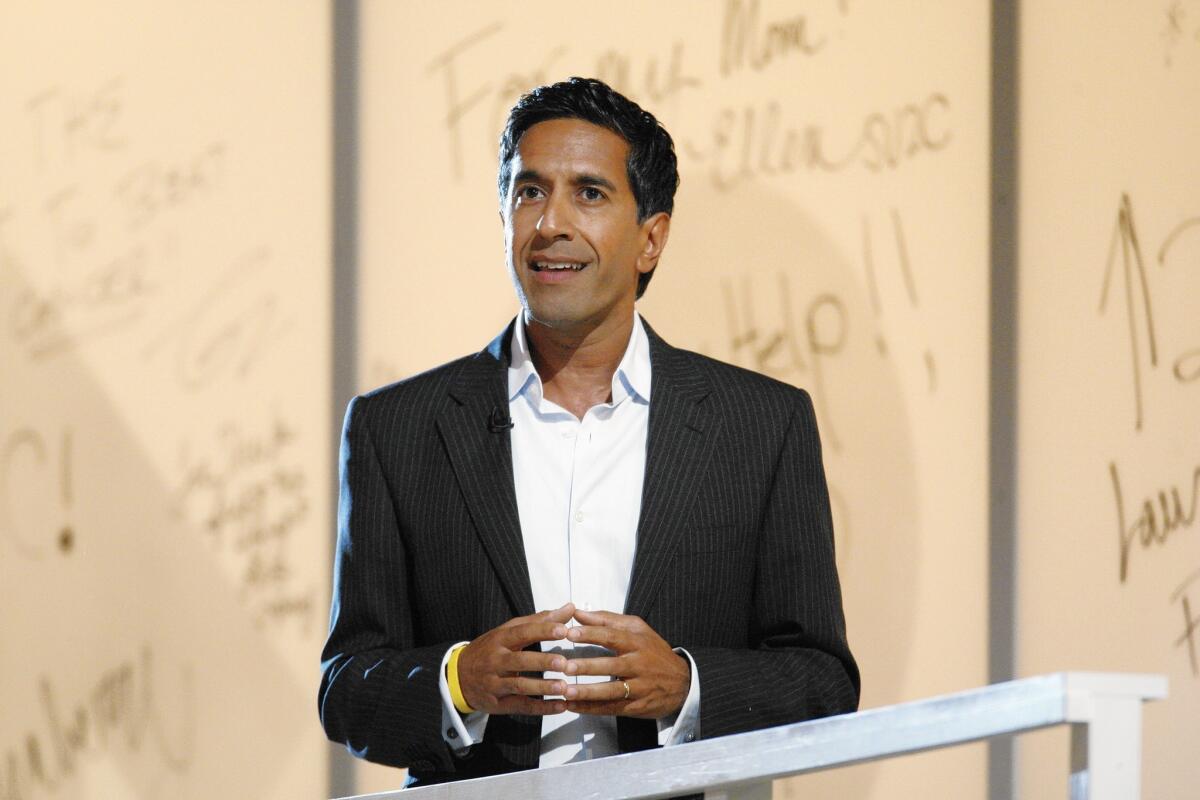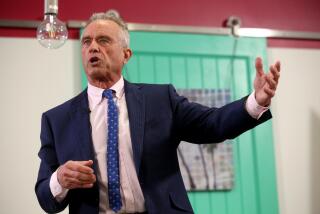Q&A: How Dr. Sanjay Gupta hit the reset button on his workout routine

Dr. Sanjay Gupta did something I’d never heard of anyone doing during an interview: 10 pull-ups.
For CNN’s longtime medical correspondent, strength training is such a key part of his multi-sport fitness regimen that he says he periodically pops off 10 quick ones throughout the day at home and office. “Nothing works the back better,” says the 45-year-old father of three, a dedicated triathlete who each September leads a group of six participants in CNN’s “Fit Nation” shape-up series to Zuma Beach, where they compete in the Nautica Malibu Triathlon. Here, the trained neurosurgeon and former White House fellow discusses his own four-sport fitness plan (swim, bike, run and weights) and why he feels it’s good for everyone.
Why did you pick triathlon for yourself and Fit Nation participants — and not a single-sport activity like a marathon?
It had to do with turning 40. I have a strong family history of heart disease in men in their 40s. Also, aging was sapping my energy and muscle mass. I had been a fairly healthy guy most of my life, playing tennis, doing some running and exercising, but the same routine was now having less impact on me. I realized that I needed to hit that reset button to optimize my fitness.
I decided on triathlon, influenced by one of my executive producers at CNN, Roni Selig, a big triathlete. And after five years of it, I feel younger now than I did at 39.
Triathlon gave my fitness program structure, variety and a sense of fun. And it reinforced my feeling that the joy of exercise was overlooked, and it could go a long way toward helping people take personal responsibility for their own health. Talking with exercise physiologists, athletes, dozens of people, we concluded that having three sports to choose from — swim, bike, run — is more accessible and physiologically better for your overall health than just doing a single sport. It was ideal for the participants in “Fit Nation,” an ongoing show at CNN where we trained six average people who wanted to hit their own reset buttons.
Triathletes routinely complain that they don’t have enough time. With three kids, a round-the-clock job, ongoing book projects, how do you fit it all in?
It’s a priority. People think of exercise as the first thing to go, and when you get busy, you can just knock that off and buy yourself another hour and a half of time. Well, I just don’t do that; it’s on my schedule. I find that it’s more efficient and less stressful that way. Human behavior is that you will fill whatever time you are given. I treat exercise with the same importance as a meeting with my boss.
I try to break a sweat every day. Studies have shown the right amount of exercise is about an hour a day. Do less, it has less benefit; do more, you plateau and even reduce the benefit. So I shoot for about an hour in one of the three — bike, swim, run. And two or three times a week I’ll do some sort of weight training. I have a pool at my office building and take my swimsuit and goggles with me while traveling.
The family understands the importance of this — and they cheer me on. If I go do a long run or ride on the weekend, I do it early so that I get home as they are waking up. They see their dad coming in having exercised. I think it’s a good message.
Most triathletes don’t seem to do strength training. Why do you?
Although our “Fit Nation” coach does recommend weight training for triathlon, I think of it more in terms of longevity. People neglect upper body strength as they get older, but it’s good for posture, bone density and even helps your lungs ward off pneumonia if you find yourself in a hospital or bedridden.
I do a fair amount in the morning — body weight stuff like push-ups and pull-ups, squats and lunges, plus presses and wood chops with weights I keep in my bedroom. Pull-ups are a great way to build your back muscles. They’re hard at first, but you start to feel the payoff almost immediately. I’ve got a door frame pull-up bar at home and here at the office — so I’ll knock them off any time. Right now, I’m wearing an earpiece as I’m talking to you, and I’m going to knock out 10 pull-ups. I’ll do core stuff on the bar with leg lifts. My wife likes to do ‘em too. We don’t run, bike or swim together, but we can do the weight and resistance stuff. Kinda nice.
(Out of breath) The upper body stuff is really good for my body and my mind. I think my wife appreciates it too; my clothes fit better.
What’s your diet like?
I abide by three principles: No. 1: “Eat breakfast like a king, lunch like a prince and dinner like a peasant.” Studies show that you eat less if you front-load, which helps me avoid the junk food that adds nothing of value to my body.
No. 2: Remember the Japanese phrase hara hachi bu, which basically means “push the plate away when you’re 80% full.” So I don’t stuff myself. It takes about 15 minutes for your stomach to catch up with your brain that you’ve had enough to eat. You can eat a three-course meal in 15 minutes.
Three, we eat a plant-based diet and don’t keep meat in the house. We only eat it when we go out. Part of it is that plant diets tend to be anti-inflammatory and seem to give me higher energy levels throughout the day. And part of it goes back to my family’s strong history of heart disease. While doing the documentary “The Last Heart Attack” with former President Clinton, who became a vegan after his heart attack, I talked with Dr. Caldwell B. Esselstyn Jr., author of “Prevent and Reverse Heart Disease.” He believes that there is some correlation between animal fats and the risk of heart attacks.
I like fish. Some studies have shown that the omega-3 fats found in fish prevent second heart attacks. I think you can take omega-3 fatty acids in the form of supplements, so I do that as well.
For a fitness program, how important is it to do a race once in a while, like the Malibu Triathlon?
We initially did “Fit Nation” without a race, but adding the triathlon for the last five years gave us several key things: an additional layer of structure for the program, a goal and a fun social aspect. Training is mainly a solitary thing, but when you do a race you have community. So much of our social lives, especially in the United States, revolves around food and drink, and not activity. And it’s too bad; going for a run together can be more enjoyable than “let’s go out and grab a beer.” Thirty people from all walks of life, with all kinds of issues, have done “Fit Nation” since 2010, and many times that are involved. I’m the team leader. During the race, I’m checking on folks, cheerleading though the race. We cross the finish line together. After five years, there’s been a 100% completion rate. Pretty good, huh?
MORE HEALTH ADVICE FROM THE STARS:
Why ‘Once Upon a Time’ star Jennifer Morrison is a fan of yoga, naps
Don’t call her a psychic: ‘Intuitive counselor’ Susan King sets up shop at Hotel Bel-Air
‘Wild’ author Cheryl Strayed says you need to be ‘be brave enough to break your own heart’










